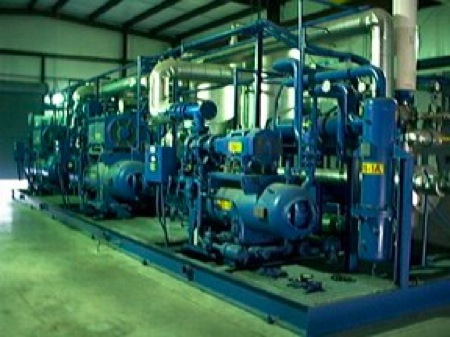and after all the pressure is relieved, a hydraulic ram presses the “snow” into a large block of dry ice. The block can then be slice into various sizes depending on what is required. In the pellet machines, liquid is continually inject into a large cylinder. The “snow” falls to the bottom of the cylinder and two wheels spinning around the bottom of the inside wall compact the “snow” as it pushes it out holes in the wall of the cylinder resulting in pellets of dry ice.
Not all of the liquid converts into the snow-like solid, some flashes back into it’s gas form. Midwest Carbonic has a “recovery skid” which pulls these gases off of the presses and pellet machines. The gas is then pressurized and condensed back into it a liquid form where it is sent back to the dry ice plant. With recycling the spent CO₂ gas roughly 7.5 tons of dry ice can be made from 10 tons of liquid, without recycling only about 4.5 tons of dry ice made from every 10 tons of liquid.
Dry ice has a temperature of -109º F. When in contact with skin these cold temperatures will cause the skin to freeze in just a few seconds, causing a burning sensation and subsequent skin damage very similar to the skin damage caused by being burnt from a heat source. Dry ice doesn’t melt like wet ice, it sublimates, meaning it changes from a solid straight to it’s gas form. The resulting CO₂ gas will displace oxygen in the area immediately surrounding it, so make sure you handle it in ventilated or open areas.




